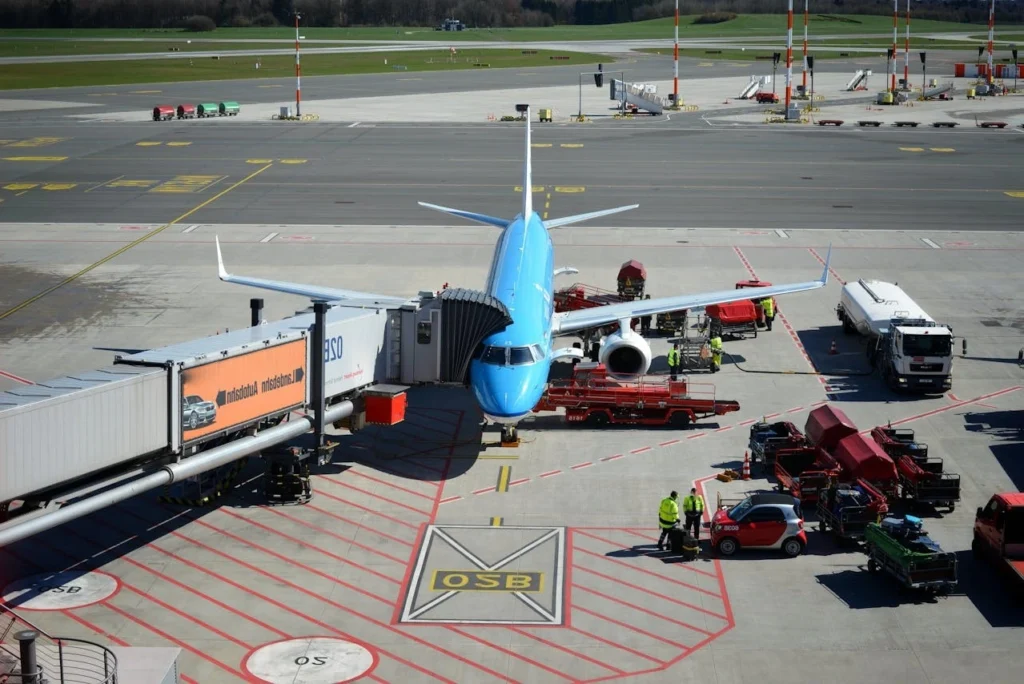
Ever wondered why your car’s regular gasoline can’t power a Boeing 747? The answer lies in the fascinating world of aviation fuel – the carefully engineered lifeblood that keeps millions of aircraft safely cruising through our skies every day.
While you might fill up your car without much thought, the fuel powering modern aircraft is a marvel of chemical engineering, designed to perform in conditions that would make your regular unleaded gasoline freeze solid.
Think about it: at 35,000 feet, temperatures can plummet below -40°C, and a single Boeing 747 can burn through a gallon of fuel every second. That’s why jet fuel isn’t just another type of gas – it’s a sophisticated blend of components specifically designed to:
- Keep flowing at extreme altitudes and temperatures
- Deliver consistent power in challenging conditions
- Meet rigorous safety standards across different climates
- Perform efficiently in various engine types
Today’s aviation industry relies on several distinct types of fuel, each engineered for specific purposes.
From the widely-used Jet A powering commercial flights across America to specialized military grades like JP-8, and the traditional AVGAS keeping smaller piston-engine aircraft airborne, each variant plays a crucial role in keeping our skies busy and safe.
In this comprehensive guide, we’ll explore the fascinating world of aviation fuel types, understanding their unique properties, applications, and the crucial differences that make each one essential.
Whether you’re an aviation enthusiast, industry professional, or simply curious about what powers those massive machines overhead, you’re about to discover:
- The key differences between various jet fuel types
- Why certain aircraft require specific fuel grades
- How aviation fuel differs from regular gasoline
- The future of sustainable aviation fuels
- Critical safety and performance considerations
Buckle up as we take flight through the complex and captivating world of aviation fuel – it’s going to be an enlightening journey!
Understanding Aviation Fuel Fundamentals: The Science Behind Flight
Ever wondered what makes jet fuel so special? At its core, it’s a sophisticated dance of chemistry and engineering, carefully orchestrated to keep aircraft safely airborne in conditions that would ground lesser fuels.
The Basic Building Blocks
Jet fuel is essentially a highly refined form of kerosene, but don’t let that simplicity fool you. While your car’s gasoline contains hydrocarbons with 7-11 carbon atoms, jet fuel steps up the game with chains of 12-15 carbon atoms. This seemingly small difference creates remarkable properties:
- Lower freezing point – crucial for high-altitude flight
- Higher flash point – enhanced safety during handling and storage
- Greater energy density – more power per gallon
- Better stability – consistent performance in varying conditions
Why Not Just Use Regular Gas?
The differences between aviation fuel and automotive gasoline are like comparing a professional athlete to a weekend warrior – both can move, but one is specifically trained for extreme conditions:
| Property | Jet Fuel | Regular Gasoline |
| Freezing Point | Below -40°C | Much higher |
| Flash Point | Higher (38°C+) | Lower |
| Energy Content | Higher | Lower |
| Additives | Anti-static, anti-icing | Octane boosters |
Commercial Jet Fuel Types: The Workhorses of Aviation
Jet A: America’s Choice
Jet A dominates the U.S. commercial aviation scene with good reason. This workhorse fuel offers:
- Freezing point of -40°C
- Flash point of 38°C
- Excellent availability across U.S. airports
- Compatible with most commercial aircraft
Jet A-1: The International Standard
Think of Jet A-1 as Jet A’s globally-minded cousin. The key differences include:
- Lower freezing point (-47°C)
- Enhanced cold-weather performance
- Standard anti-static additives
- Wider international availability
Both fuels share important characteristics that make them ideal for commercial aviation:
- Safety Features:
- High flash points for safer handling
- Stability at various altitudes
- Resistance to vapor lock
- Performance Requirements:
- Consistent power delivery
- Excellent thermal stability
- Low susceptibility to water contamination
Storage and Handling: The Critical Details
Proper storage and handling of jet fuel requires military-grade precision:
- Temperature-controlled storage facilities
- Regular quality testing and certification
- Specialized handling equipment
- Strict contamination prevention protocols
- Advanced filtration systems
Remember, when you’re dealing with aircraft consuming up to one gallon per second during flight, there’s zero room for error in fuel quality or handling procedures.
Specialized Aviation Fuels: Meeting Unique Operational Demands
Wide-Cut Warriors: Jet B and Beyond
Let’s talk about the adventurous cousin in the jet fuel family – Jet B. Think of it as the winter-ready specialist, blending:
- 70% gasoline for better cold-weather starts
- 30% kerosene for sustained performance
- Ultra-low freezing point (-60°C)
- Higher volatility for extreme conditions
Why so specialized? Imagine trying to start an aircraft in Alaska’s -40°C weather. That’s where Jet B shines, though its higher volatility means it’s primarily found in cold-climate regions.
Military-Grade Might: JP-8 and JP-5
The military doesn’t mess around when it comes to fuel specifications. Their specialized grades include:
JP-8 (Military Workhorse)
- Based on Jet A-1 specifications
- Enhanced with:
- Corrosion inhibitors
- Anti-icing agents
- Static dissipater
- Used by NATO forces worldwide
JP-5 (Naval Operations)
- Higher flash point (60°C)
- Enhanced safety for carrier operations
- Complex hydrocarbon blend
- Specialized for maritime environments
Regional Variants: Global Solutions
TS-1 (Russian Standard)
- Higher volatility than Jet A-1
- Lower freezing point (<-50°C)
- Ideal for extreme cold climates
- Used throughout CIS countries
Chinese Jet Fuel Family
- No.1-5 grades for different applications
- No.3 similar to Jet A-1 (most common)
- No.4 comparable to Jet B
- No.5 aligned with JP-5 specifications
AVGAS: The High-Performance Classic
Understanding Aviation Gasoline
AVGAS remains crucial for piston-engine aircraft, offering:
- Higher octane ratings than jet fuel
- Performance-enhancing additives
- Specific grades for different engine types
- Consistent power delivery
Current Grades and Applications
- AVGAS 100 (Green)
- High lead content
- Maximum performance
- Used in high-compression engines
- AVGAS 100LL (Blue)
- Lower lead content
- Wide application range
- Most common grade today
The Lead Challenge
The aviation industry faces a crucial transition with lead content in AVGAS:
- Traditional tetraethyl lead use
- Environmental and health concerns
- FAA approval of G100UL (unleaded alternative)
- Industry adaptation challenges
Safety and Quality Control: Zero Room for Error
Testing and Certification
- Regular quality checks
- Particle contamination monitoring
- Water content verification
- Flash point testing
Critical Safety Protocols
- Storage Requirements:
- Temperature-controlled facilities
- Moisture prevention systems
- Regular tank inspection
- Proper ventilation
- Handling Procedures:
- Specialized equipment use
- Static electricity prevention
- Proper grounding techniques
- Personal protective equipment
- Contamination Prevention:
- Multi-stage filtration
- Regular system cleaning
- Microbial growth prevention
- Water separation processes
Emergency Response
- Immediate containment procedures
- Fire safety protocols
- Spill response guidelines
- Emergency communication chains
Environmental Impact and Sustainability: Aviation’s Green Horizon
The Carbon Challenge
Let’s face it – traditional aviation fuel leaves a significant environmental footprint. A typical international flight burns through fuel at an astonishing rate, with a Boeing 747 consuming approximately one gallon per second. This translates to:
- Direct CO2 emissions
- High-altitude climate impact
- NOx and particulate matter release
- Substantial carbon footprint per passenger mile
Sustainable Aviation Fuel (SAF): The Game Changer
The industry is rapidly embracing sustainable alternatives that offer:
- Up to 80% reduction in carbon emissions
- Drop-in capability with existing infrastructure
- Similar performance characteristics
- Growing availability worldwide
Current Environmental Regulations
- ICAO emissions standards
- Regional carbon taxation
- Sustainability reporting requirements
- Noise and emissions restrictions
Economic Landscape: Understanding the Numbers
Market Dynamics
- Global supply chain influences
- Regional price variations
- Competition with ground transport
- Emergency reserves requirements
Current price factors include:
- Crude oil market fluctuations
- Refining capacity limitations
- Transportation costs
- Regional demand variations
Future Cost Projections
- SAF integration impact
- Infrastructure development needs
- Technology advancement effects
- Regulatory compliance costs
The Future Takes Flight: Tomorrow’s Aviation Fuel
Emerging Technologies
- Hydrogen fuel development
- Electric hybrid systems
- Biofuel innovations
- Synthetic fuel research
Industry Trends
- Increasing SAF adoption
- Infrastructure modernization
- Enhanced efficiency requirements
- Digital fuel management systems
Performance Optimization: Getting the Most from Every Drop
Efficiency Strategies
- Flight planning optimization
- Weight management
- Route efficiency
- Maintenance practices
Temperature and altitude considerations:
| Factor | Impact | Optimization |
| Temperature | Density changes | Timing adjustments |
| Altitude | Fuel efficiency | Optimal cruise levels |
| Weight | Consumption rate | Load balancing |
Troubleshooting Guide: When Things Go Wrong
Common Issues and Solutions
Quick Reference Table:
| Problem | Possible Cause | Initial Action | Professional Help Needed? |
| Poor performance | Contamination | Quality check | Yes |
| Freezing issues | Wrong grade | Verify fuel type | Yes |
| System clogging | Debris buildup | Filter inspection | Yes |
Emergency Response Protocol
- Immediate assessment
- Documentation
- Professional consultation
- Corrective action

